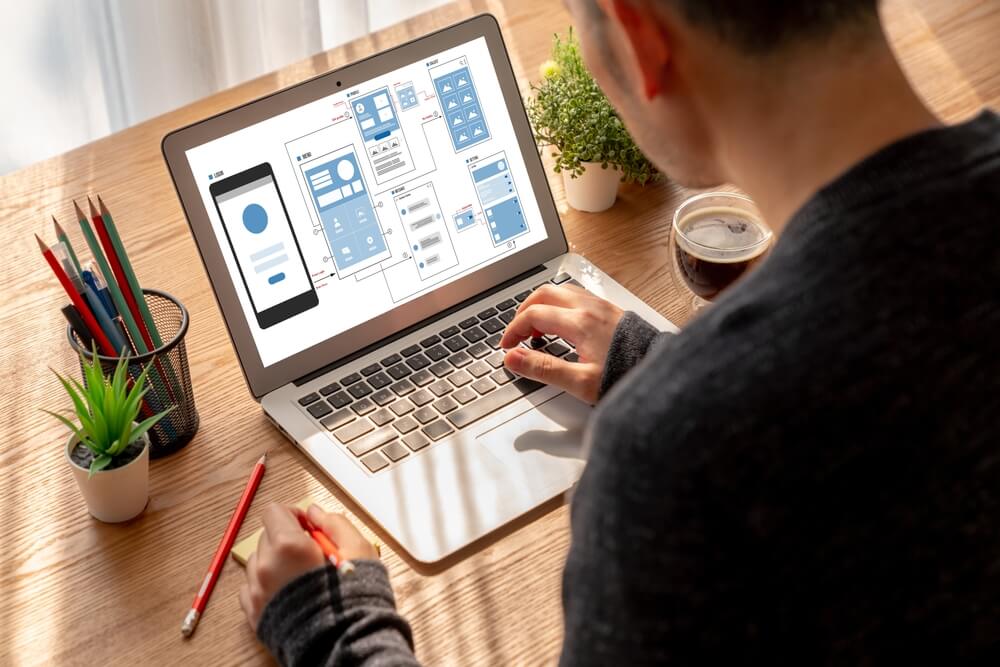
9 Common UX Design Fails and How You Can Avoid Them
A website with good user experience (UX) design better engages visitors and promotes the company’s brand, products, or services. By partnering with an experienced UX agency, businesses can avoid the following common UX design fails:
 Not taking user needs and feedback seriously is problematic because it disconnects the design from the users’ actual needs and expectations. This also leads to poor user experience, decreased user satisfaction, and low adoption and usage of the product or website.
Avoid this issue by considering these techniques:
Not taking user needs and feedback seriously is problematic because it disconnects the design from the users’ actual needs and expectations. This also leads to poor user experience, decreased user satisfaction, and low adoption and usage of the product or website.
Avoid this issue by considering these techniques:
 Forgetting to optimize the in-between UX or the transitional states or interactions within an interface becomes an issue for UX design. It creates confusion and frustration and disrupts the overall UX flow.
Neglecting these in-between interactions also leads to a disjointed and inconsistent user journey. Prevent this issue by optimizing the following in-between interactions:
Forgetting to optimize the in-between UX or the transitional states or interactions within an interface becomes an issue for UX design. It creates confusion and frustration and disrupts the overall UX flow.
Neglecting these in-between interactions also leads to a disjointed and inconsistent user journey. Prevent this issue by optimizing the following in-between interactions:
 There is a fine line between being informative and giving too much information. The latter affects good UX design because it tends to overwhelm users, create cognitive overload, and hinder their ability to find relevant information.
Excessive information leads to confusion, decision paralysis, and frustration. Designers must avoid providing too much information by considering these practices:
There is a fine line between being informative and giving too much information. The latter affects good UX design because it tends to overwhelm users, create cognitive overload, and hinder their ability to find relevant information.
Excessive information leads to confusion, decision paralysis, and frustration. Designers must avoid providing too much information by considering these practices:
 Overlooking links and buttons in UX design can lead to broken or dysfunctional links and buttons, which causes user frustration and hinders task completion. Users rely on links and buttons to navigate, access information, and perform actions, so guaranteeing proper functioning is crucial.
UX designers must follow these strategies to avoid overlooking these design elements:
Overlooking links and buttons in UX design can lead to broken or dysfunctional links and buttons, which causes user frustration and hinders task completion. Users rely on links and buttons to navigate, access information, and perform actions, so guaranteeing proper functioning is crucial.
UX designers must follow these strategies to avoid overlooking these design elements:
- Forgetting the balance between aesthetics and function.
- Not taking user needs and feedback seriously.
- Using too many pop-ups.
- Not optimizing in-between UX.
- Following various trends.
- Providing too much information.
- Adding unresponsive elements.
- Not checking links and buttons.
- Ignoring a responsive design.
To learn how Digital Authority Partners can create a standout website for you, watch this video!
1. Forgetting the Balance Between Aesthetics and Function
There must be a balance between aesthetics and functionality in UX design. Otherwise, it becomes problematic. It leads to either a visually appealing but poorly usable interface or a highly functional but visually unappealing one. Both scenarios negatively impact the user experience. Aesthetics attract users, giving a positive impression and enhancing brand perception. Functionality ensures that users accomplish their goals and effectively navigate the interface. Avoid an imbalance by following these practices:- Conduct user research to secure valuable insights into the balance between aesthetics and functionality.
- Embrace a user-centered design. Involve users in usability testing and gather feedback to ensure that the design meets their requirements.
- Collaborate between UX designers, visual designers, and developers to achieve the balance of aesthetics and functionality.
- Iterate on designs and conduct user testing at various stages of the design process.
- Follow design principles such as simplicity, consistency, and hierarchy.
2. Not Taking User Needs and Feedback Seriously
 Not taking user needs and feedback seriously is problematic because it disconnects the design from the users’ actual needs and expectations. This also leads to poor user experience, decreased user satisfaction, and low adoption and usage of the product or website.
Avoid this issue by considering these techniques:
Not taking user needs and feedback seriously is problematic because it disconnects the design from the users’ actual needs and expectations. This also leads to poor user experience, decreased user satisfaction, and low adoption and usage of the product or website.
Avoid this issue by considering these techniques:
- Listen and engage with users, encourage user feedback throughout the design process, and create channels to provide input.
- Implement an iterative design process that includes regular testing and refinement.
- Use empathy toward users by putting yourself in the users’ shoes and prioritizing their needs and goals throughout the design process.
- Collaborate with users throughout the design process, involving them in co-creation workshops, design reviews, or usability testing sessions.
3. Using Too Many Pop-ups
Too many popups harm UX design because they disrupt the user experience, create annoyance, and potentially lead to user frustration or abandonment. Excessive pop-ups also stop users from accessing desired content, interrupt their workflow, and negatively impact the overall usability of the interface. These issues are avoidable using these techniques:- Ensure that popups are relevant to the user’s context and presented at appropriate times. For example, displaying pop-ups during natural breaks in user flow or when they have completed a specific action.
- Opt for alternatives (e.g., using in-line messages, contextual tooltips, or discreet banners).
- Provide straightforward ways to dismiss or close popups. Implement visible and intuitive close buttons or clear instructions on how to close the popup.
- Conduct A/B testing to evaluate the impact and user response to popups.
4. Not Optimizing In-Between UX
 Forgetting to optimize the in-between UX or the transitional states or interactions within an interface becomes an issue for UX design. It creates confusion and frustration and disrupts the overall UX flow.
Neglecting these in-between interactions also leads to a disjointed and inconsistent user journey. Prevent this issue by optimizing the following in-between interactions:
Forgetting to optimize the in-between UX or the transitional states or interactions within an interface becomes an issue for UX design. It creates confusion and frustration and disrupts the overall UX flow.
Neglecting these in-between interactions also leads to a disjointed and inconsistent user journey. Prevent this issue by optimizing the following in-between interactions:
- Identify the critical in-between interactions within the user journey, such as loading states, form submissions, error handling, or transitions between screens.
- Use visual cues and feedback to inform users about their actions’ progress or the system’s status. Use loading spinners, progress bars, or animated transitions.
- Evaluate the in-between interactions and look for opportunities to streamline and simplify them.
- Conduct usability testing and gather user feedback, specifically on the in-between interactions.
- Maintain a consistent design language throughout the in-between interactions to provide a cohesive and familiar experience.
5. Following Various Design Trends
New trends in UX design consistently emerge, and adopting each strategy is costly. This may result in a straightforward strategy where the user needs or business objectives are secondary to the desire to be fashionable or aesthetically pleasing. Relying too heavily on trends results in a lack of uniqueness, poor usability, and an inconsistent experience. To avoid issues with design trends, UX designers should consider the following:- Place the needs and preferences of the target users at the forefront of the design process.
- Aim for a balance between contemporary aesthetics and timeless design principles.
- Establish a consistent design language and adhere to it throughout the interface.
- Evaluate design trends to determine their suitability for the specific project and target audience.
6. Providing Too Much Information
 There is a fine line between being informative and giving too much information. The latter affects good UX design because it tends to overwhelm users, create cognitive overload, and hinder their ability to find relevant information.
Excessive information leads to confusion, decision paralysis, and frustration. Designers must avoid providing too much information by considering these practices:
There is a fine line between being informative and giving too much information. The latter affects good UX design because it tends to overwhelm users, create cognitive overload, and hinder their ability to find relevant information.
Excessive information leads to confusion, decision paralysis, and frustration. Designers must avoid providing too much information by considering these practices:
- Prioritize essential and relevant information that users need to accomplish their goals.
- Use headings, subheadings, and bullet points to organize and structure information.
- Break down information into manageable chunks and group related content together.
- Use clear and concise language, avoiding jargon, complex terminology, and unnecessary technical details.
- Use progressive disclosure to reveal information as users progress through a task or explore options.
7. Adding Unresponsive Elements
Unresponsive elements in UX design leads to user frustration, confusion, and poor overall user experience. These do not react or respond as expected when interacted with, making it difficult for users to understand the system’s behavior or accomplish their tasks. UX designers should consider the following to avoid unresponsive page elements:- Use visual cues such as hover effects, button states, and animation to indicate responsiveness in interactive elements.
- Design interactions that match user expectations and conventions. Consider the established standards to ensure that users are able to intuitively use buttons, links, and form fields.
- Address user errors and invalid inputs with proper error handling. Users should be able to quickly identify and correct errors by viewing error messages near relevant form fields or interactions.
- Conduct usability testing with a diverse group of users to identify any unresponsive elements or areas of confusion.
- Consider the device and platform. Ensure interactive elements work across screen sizes, browsers, and operating systems.
8. Not Checking Links and Buttons
 Overlooking links and buttons in UX design can lead to broken or dysfunctional links and buttons, which causes user frustration and hinders task completion. Users rely on links and buttons to navigate, access information, and perform actions, so guaranteeing proper functioning is crucial.
UX designers must follow these strategies to avoid overlooking these design elements:
Overlooking links and buttons in UX design can lead to broken or dysfunctional links and buttons, which causes user frustration and hinders task completion. Users rely on links and buttons to navigate, access information, and perform actions, so guaranteeing proper functioning is crucial.
UX designers must follow these strategies to avoid overlooking these design elements:
- Use a thorough quality assurance (QA) process to test all interface links and buttons.
- Test links and buttons for form submissions, error states, edge cases, and user-specific actions.
- Conduct usability testing in the design process to observe how users interact with links and buttons.
- Implement clear visual signifiers, such as contrasting colors, hover effects, or affordances, to indicate interactive elements.
- Perform regular checks and maintenance to ensure that links and buttons remain functional and up to date.
9. Ignoring a Responsive Design
A site with an unresponsive design is problematic because it triggers poor user experiences on different devices and screen sizes. With so many mobile devices, users expect interfaces to seamlessly adapt and function across various screen resolutions. Failing to implement a responsive design may result in content distortion, difficulty in navigation, and frustration. Avoid this issue with these techniques:- Embrace a mobile-first approach. First, optimize the interface for smaller screens, then scale up for larger screens.
- Conduct user research to understand their preferred devices, screen sizes, and usage patterns.
- Implement fluid grids and flexible layouts that adapt to different screen sizes.
- Ensure text, images, and media scale and reflow for different screen sizes.
- Test the responsive design on smartphones, tablets, and desktops to make sure of consistent and optimized experiences across screen sizes.
Summing Up
Avoid these common UX design issues to ensure a well-developed, professional-looking, engaging website that promotes your company’s goals and supports your customers’ needs. Websites and apps with the best UX design contribute to the success of digital marketing campaigns for businesses, big or small. Learn more about UX design issues and how to prevent them by contacting an experienced UX agency. Call Digital Authority Partners (DAP) today.Want To Meet Our Expert Team?
Book a meeting directly here



